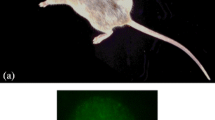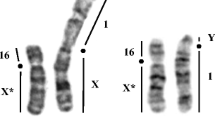Abstract
Different rules hold for X chromosome inactivation (Lyon 1961) in mammalian cells of early embryonic, gonadal or somatic origin. In preimplantation female embryos both X chromosomes are active. After implantation, however, the paternally derived X is preferentially inactivated in extraembryonic tissues while the random inactivation of either paternal or maternal X occurs in primitive ectoderm which gives rise to the embryo proper later on (for recent review see West 1982).
Access this chapter
Tax calculation will be finalised at checkout
Purchases are for personal use only
Preview
Unable to display preview. Download preview PDF.
Similar content being viewed by others
References
Andina, R. J. 1978 A study of X chromosome regulation during oogenesis in the mouse. Expl. Cell Res. 111, 211–18.
Baker, B. S. and D. L. Lindsley 1982 The genetic control of sex determination and male fertility in Drosophila melanogaster. In Genetic control of gamete production and function. P. G. Crosignani, B. L. Rubin and M. Fraccaro, eds., 153–70. New York and London, Grune and Stratton: Academic Press.
Boer, P. de, F. A. van der Hoeven and J. A. P. Chardon 1976 The production, morphology, karyotypes and transport of spermatozoa from tertiary trisomic mice and the consequences for egg fertilization. J. Reprod. Fertil. 48, 249–56.
Boer, P. de and H. E. B. Branje 1979 Association of the extra chromosome of tertiary trisomic male mice with the sex chromosomes during first meiotic prophase, and its significance for impairment of spermatogenesis. Chromosoma (Berl.) 73, 369–79.
Boer, P. de, A. G. Searle, F. A. van der Hoeven and C. V. Beechey 1980 Spermatocyte meiotic pairing of the T(5;12)31H T(6;12)32H, T(11;19)42 male-sterile and the T(1;13)70H male-fertile reciprocal translocations in the mouse using silver staining of synaptonemal complexes. Cytogenet. Cell Genet. 27, 202–03.
Boer, P. de and J. H. Nijhoff 1981 Incomplete sex chromosome pairing in oligospermic male hybrids of Musmusculus and M. musculusmolossinus in relation to the source of the Y chromosome and the presence or absence of a reciprocal translocation. J. Reprod. Fert. 62, 235–43.
Boer, P. de and M. E. A. B. van Beek 1982 Meiosis of T70H translocation trisomic male mice. I. Meiotic configurations and segregation. Chromosoma (Berl.) 87, 303–13.
Boer, P. de and R. M. Speed 1982 Meiosis of translocation trisomic male mice, II. Meiotic rate, spermatocyte interactions and fertility. Chromosoma (Berl.) 87, 315–25.
Cacheiro, N. L. A,, L. B. Russell and M. S. Swartout 1974 Translocations, the predominant cause of total sterility of sons of mice treated with mutagens. Genetics 76, 73–91.
Chandley, A.C. 1979 The chromosomal basis of human infertility. Brit. Med. Bull. 35, 181–86.
Chandley, A. C. 1982 A pachytene analysis of two male-fertile paracentric inversions in chromosome 1 of the mouse and in male-sterile double heterozygote. Chromosoma (Berl.) 85, 127–35.
Dobzhansky, T. 1951 Genetic and the origin of species, 3rd ed., Columbia University Press, New York.
Davisson, M. T., P. A. Poorman, T. H. Roderick and M. J. Moses 1981 A penicentric inversion in the mouse. Cytogenet. Cell Genet. 30, 70–76.
Epstein, C. J. 1969 Mammalian oocytes: X chromosome activity. Science 163, 1078.
Ford, C. E., A. G. Searle, E. P. Evans and B. J. West 1969 Differential transmission of translocations induced in spermatogonia of mice by irradiation. Cytogenetics 8, 447–70.
Forejt, J. 1974 Nonrandom association between a specific autosome and the X chromosome in meiosis of the male mouse: possible consequence of homologous centromere separation. Cytogenet. Cell Genet. 13, 369–83.
Forejt, J. 1976 Spermatogenic failure of translocation heterozygotes affected by H-2-linked gene in mouse. Nature 260, 143–45.
Forejt, J. 1979 Meiotic studies of translocations causing male sterility in the mouse. II. Double heterozygotes for Robertsonian translocations. Cytogenet. Cell Genet. 23, 163–70.
Forejt, J. 1980 X and Y involvement in autosomal male-sterile translocations. Cytogenet. Cell Genet. 27, 204–05.
Forejt, J. 1981 Hybrid sterility gene located in the Tut-H-2 supergene on chromosome 17. In Current trends in histocompatibility, vol. 1, R.A. Reisfeld and S. Ferrone, eds., 103–31. New York, London: Plenum Press.
Forejt, J. 1982 X-Y involvement in male sterility caused by autosome translocations–a hypothesis. In Genetic control of gamete production and function, P. G. Crosignani, B. L. Rubin and M. Fraccaro, eds., 135–51. New York, London: Grune and Stratton, Academic Press.
Forejt, J. and S. Gregorová 1977 Meiotic studies of translocations causing male sterility in the mouse. I. Autosomal reciprocal translocations. Cytogenet. Cell Genet. 19, 159–79.
Forejt, J., J. Čapková and S. Gregorová 1980 T(16;17) 43H translocation as a tool in analysis of the proximal part of chromosome 17 (including T-t gene complex) of the mouse. Genet. Res. 35, 165–77.
Forejt, J., S. Gregorová and P. Goetz 1981 XY pair associates with the synaptonemal complex of autosomal male-sterile translocations in pachytene spermatocytes of the mouse (Mus musculus). Chromosoma (Berl.) 82, 41–53.
Gregorová S., V. S. Baranov and J. Forejt 1981 Partial trisomy effect on male fertility and the transmission to progeny. Folia biol. (Praha) 27, 171–77.
Gropp, A., H. Winking and C. Redi 1982 Consequences of Robertsonian heterozygosity: segregational impairment of fertility versus male-limited sterility. In Genetic control of gamete production and function, P. G. Crosignani, B. L. Rubin and M. Fraccaro, eds., 115–34. New York, London: Grune and Stratton, Academic Press.
Holm, P.B. and S.W. Rasmussen 1978 Human meiosis. III. Electron microscopical analysis of chromosome pairing in an individual with a balanced translocation 46, XY t(5p-;22p+). Carlsberg Res. Commun. 43, 329–50.
Hotta, Y. and A. C. Chandley 1982 Activities of X-linked enzymes in spermatocytes of mice rendered sterile by chromosomal alterations. Gamete Res. 6, 65–72.
Johannisson, R., A. Gropp, H. Winking W. Coerdt, H. Rehder and E. Schwinger 1983 Down s syndrome in the male. Reproductive pathology and meiotic studies. Hum. Genet. 63, 132–38.
Lifschytz, E. and D.L. Lindsley 1972 The role of X-chromosome inactivation during spermatogenesis. Proc.Natl.Acad.Sci. (Wash.) 69, 182–86.
Lyon, M.F. 1961 Gene action in the X-chromosome of the mouse, Mus musculus. Nature 190, 372–73.
Lyon, M.F. and R. Meredith 1966 Autosomal translocations causing male sterility and viable aneuploidy in the mouse. Cytogenetics 5, 335–54.
Madan, K. 1983 Balanced structural changes involving the human X: Effect on sexual phenotype. Hum. Genet.63, 216–21.
Mahadeaian, S. and U. Mittwoch 1983 Pachytene analysis of male and female mice heterozygous for the Is (7;1)40H insertion. Genet. Res. 14, 317.
Monk, M. and A. McLaren 1981 X-chromosome activity in foetal germ cells of the mouse. J. Embryol. Exp. Moorrhol. 63, 75–84.
Searle, A.G. 1974 Nature and consequences of induced chromosome damage in mammals. Genetics 78, 173–86.
Searle, A.G. 1981 Numerical variants and structural rearrangements. In Genetic variants and strains of the laboratory mouse, M. C. Green, ed., 324–59. Gustav Fisher Verlag, Stuttgart.
Searle, A.G., C.V. Beechey and E. P. Evans 1978 Meiotic effect in chromosomally derived male sterility of mice. Ann. Biol. anim. Biochem. Biophys. 18, 391–98.
Speed, R.M. 1980 Autoradiographic studies of translocation trisomies in the male mice. Cytogenet. Cell Genet. 27, 212.
West, J.D. 1982 X chromosome expression during mouse embryogenesis. In Genetic control of gamete production and function, P. G. Crosignani, B. L. Rubin and M. Fraccaro, eds., 49–92. New York, London: Grune and Stratton, Academic Press.
Author information
Authors and Affiliations
Editor information
Editors and Affiliations
Rights and permissions
Copyright information
© 1984 The Organising Committee of the VIII International Chromosome, Conference, Lübeck
About this chapter
Cite this chapter
Forejt, J. (1984). X-inactivation and its role in male sterility. In: Bennett, M.D., Gropp, A., Wolf, U. (eds) Chromosomes Today. Springer, Dordrecht. https://doi.org/10.1007/978-94-010-9163-3_11
Download citation
DOI: https://doi.org/10.1007/978-94-010-9163-3_11
Publisher Name: Springer, Dordrecht
Print ISBN: 978-94-010-9165-7
Online ISBN: 978-94-010-9163-3
eBook Packages: Springer Book Archive




